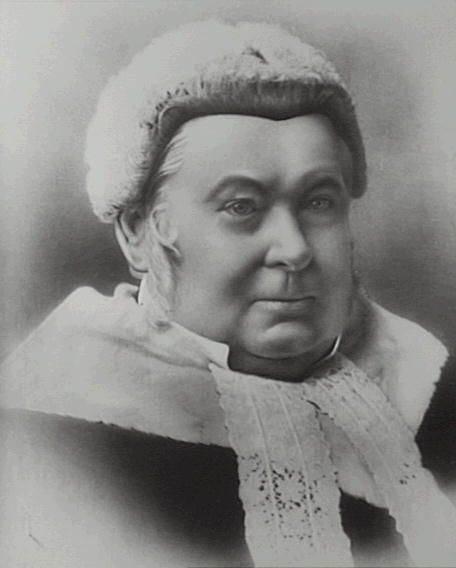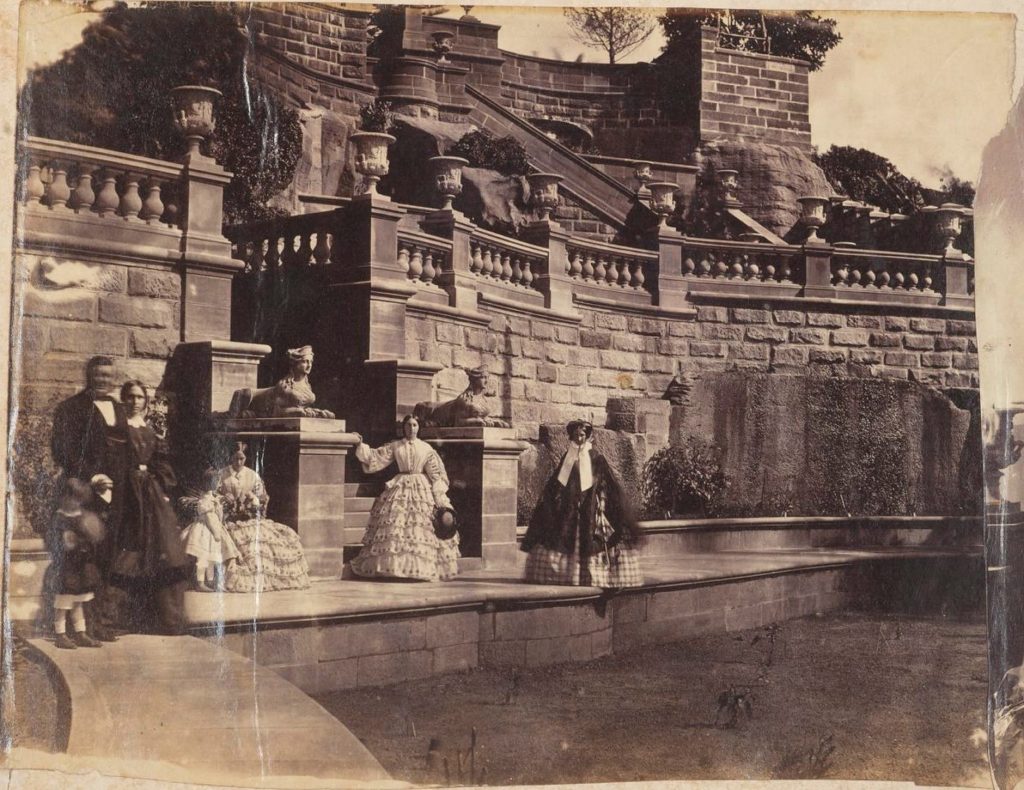
Sir James Martin, photograph thought to be taken between 1873 – 1879. (Source: Blue Mountains City Library)
James Martin was born on the 14th May 1820 in County Cork, Ireland. His parents, Mary and John Martin, migrated to Australia and arrived in Sydney on November 6th, 1821 [1].
John Martin was employed at Government House as a groom [2] having previously worked as a steward at Castle Hyde in Ireland.
His son, James Martin, grew up in Parramatta in the family home which was an adjoining groom’s cottage at Government House stables, surrounded by what is now Parramatta Park. It is believed, based on his writings and later conversations held with members of his family [3], that Martin walked to school at Sydney College which was a 20-kilometre walk. Despite his young age, Martin was not nervous about this walk as he noted that the road would be busy with farmers travelling to the markets and locals passing by in their carriages. Late in 1834, the Martin family moved to Sydney where John Martin had found work at Grose Farm (now University of Sydney and Victoria Park) located on Parramatta Road.

Porto Jackson [Government House at Parramatta] [picture] [ca. 1835]. National Library of Australia, nla.obj-137045594
His interest in writing eventually led him to write and publish his own book in 1838, a collection of essays called The Australian Sketchbook. The book contained fifteen essays, covering topics such as his former school tutor, his trips to Botany Bay and what Christmas was like in Australia [8]. Digital scans of the Australian Sketchbook can be viewed on the National Library of Australia’s website. One of these essays, Bondi Bay, was recently republished in the anthology from 2014 entitled Bondi Stories.
In 1839, Martin became the acting editor of The Australian when editor George Robert Nichols, started spending more time in his legal practice which he ran with John Williams. In 1840, Nichols resigned from The Australian when he was admitted to the Bar. It was at this time Martin, too, had a change of prospects when he started work as an articled clerk at the Nichols and Williams partnership. Martin served on the Wentworth-Bland election committee at the age of 23.
In 1845 Martin moved on from Nichols and Williams and, having been made an attorney in the Supreme Court, Martin expanded his business by opening up his own offices in Parramatta and on Pitt Street in Sydney [9].
Around this period, Martin took on a more active role in politics, and in 1848 he stood for the electorate of Durham. After an initial defeat at the previous election, Martin was elected at a second by-election and was now the Honourable member for Cook and Westmoreland [10].
James Martin married Isabella Long on the 20th of January, 1853 at St Peter’s Church, Cook’s River. Isabella, the daughter of Mr. and Mrs. Long of Potts Point; Mr. Long being a wealthy ex-convict and made his business from importing alcohol [11].
Martin and Isabella settled at Clarens, a two-storey villa located in Potts Point, not far from Isabella’s family home of Tusculum. Over the years, the Martins welcomed the birth of eight sons and seven daughters. Martin invested much time and money into developing the gardens of Clarens, choosing many exotic plants including the newly introduced Jacaranda Trees [12] nick-named fondly by the Martin children as ‘Dream Trees’ [13].

James and Isabella Martin and family at Clarens, Potts Point, Sydney, around 1860. Image Source: Caroline Simpson Library & Research Collection, Sydney Living Museums.
James Martin served as attorney-general twice in the period of c.1856 – 1858. During this period Martin was accepted into The Bar, in 1857. On October 20, 1863 he became Premier of New South Wales after the resignation of Charles Cowper. This ministry lost power at the end of 1864 with Charles Cowper again becoming Premier. James Martin would go on to hold the position of Premier a further two times; from 1866-1868 and from 1870-1872. In 1869 he was made a Knight Commander of the Order of the Bath [14].
In 1873, at the resignation of Sir Alfred Stephen, Premier Parkes announced the new Chief Justice, Sir James Martin. In 1879, Martin took six months leave from the position due to ill health. While on leave, Martin spent his time between Clarens in Potts Point and his beloved holiday home Numantia which was located near Springwood in the Blue Mountains [15]. Lady Martin, concerned about its health and size, insisted that Clarens was not a suitable house for a larger family, nor was she happy with Numantia. The death of two children in 1880-81 convinced Lady Martin of her view and she rented out, Greycliffe, a house located in Vaucluse. This period of time saw a separation in the Martins marriage that lasted until 1885 [16].
Sir James Martin passed away on the 4th of November, 1886 of heart failure. His burial place was St Jude’s at Randwick, however his remains were later transferred to lay to rest beside Lady Martin upon her death in 1909. Their graves are located in Waverley Cemetery in the eastern suburbs of Sydney. In 1892, Martin Place in the central business district of Sydney was dedicated to Martin in his memory [17].
![]() Alysha Esdaile, Volunteer Collections Assistant, City of Parramatta, Parramatta Heritage Centre, 2017.
Alysha Esdaile, Volunteer Collections Assistant, City of Parramatta, Parramatta Heritage Centre, 2017.
References:
[1] Grainger, E. (1970). Martin of Martin Place: a biography of Sir James Martin. Sydney: Alpha Books. p. 1.
[2] Bede, N. (1974). Martin, Sir James (1820–1886). Retrieved October 29, 2017, from Australian Dictionary of Biography: http://adb.anu.edu.au/biography/martin-sir-james-4161
[3] Grainger, E. (1970). Martin of Martin Place: a biography of Sir James Martin. Sydney: Alpha Books. p. 11.
[4] Grainger, E. (1970). Martin of Martin Place: a biography of Sir James Martin. Sydney: Alpha Books. P. 12.
[5] Grainger, E. (1970). Martin of Martin Place: a biography of Sir James Martin. Sydney: Alpha Books. p. 17.
[6] Grainger, E. (1970). Martin of Martin Place: a biography of Sir James Martin. Sydney: Alpha Books.
[7] Grainger, E. (1970). Martin of Martin Place: a biography of Sir James Martin. Sydney: Alpha Books. p. 18.
[8] Martin, J. (1838). The Australian Sketchbook. Sydney: James Tegg. pp. 257-284
[9] Grainger, E. (1970). Martin of Martin Place: a biography of Sir James Martin. Sydney: Alpha Books. p. 34.
[10] Wikipedia. (2017, August 28). James Martin (Australian Politician). Retrieved October 29, 2017 from Wikipedia: https://en.wikipedia.org/wiki/James_Martin_(Australian_politician)
[11] Bennett, J. M. (2005). Sir James Martin: Premiere and Chief Justice of New South Wales. Sydney: Federation Press. p. 121.
[12] Grainger, E. (1970). Martin of Martin Place: a biography of Sir James Martin. Sydney: Alpha Books. p. 75.
[13] Curran, H. (n.d.). The Dream Tree: Jackaranda, Sydney Icon. Retrieved October 29, 2017 from Sydney Living Museums: https://sydneylivingmuseums.com.au/stories/dream-tree-jacaranda-sydney-icon
[14] Wikipedia. (2017, August 28). James Martin (Australian Politician). Retrieved October 29, 2017 from Wikipedia: https://en.wikipedia.org/wiki/James_Martin_(Australian_politician)
[15] Grainger, E. (1970). Martin of Martin Place: a biography of Sir James Martin. Sydney: Alpha Books. p.141.
[16] Grainger, E. (1970). Martin of Martin Place: a biography of Sir James Martin. Sydney: Alpha Books. pp.138-143.
[17] Bede, N. (1974). Martin, Sir James (1820–1886). Retrieved October 29, 2017, from Australian Dictionary of Biography: http://adb.anu.edu.au/biography/martin-sir-james-4161


